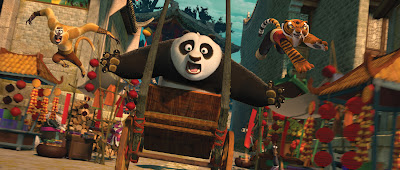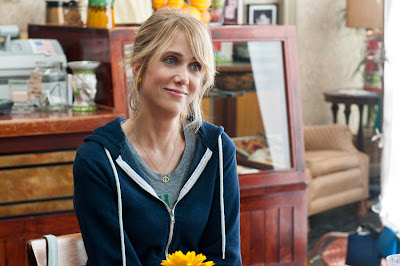Here’s my mini review:
Praise the panda. Prattling Po — plushy, perfectly plump and plagued with precociousness — ponders private parentage problems and protects his peaceful, panic-prone people in a peppy post-prequel packed with punkish pyrotechnics, pleasant protagonists, polished plots, persistent perkiness and prickly pirates in Panda Part 2. Partake the picture perhaps? I proudly proclaim in the positive.
Now the full review, which is good because I was running out of context-appropriate “P” words.
I am quite fond of the first Kung Fu Panda, which was all kinds of silly. Now here’s Kung Fu Panda 2, a sequel that begs to be so much more than the first one simply because it doesn’t deviate from the original’s charm.
Panda 2 is mostly more of what made the first film so delightful: Jack Black’s goofy humor, realistic kung fu, and an animation style that is quite simply beautiful with its deep textures and rich colors. The sequel goes beyond the first film, though, if only because it adds layers to the star, a lovable panda named Po , who still has learning and growing to undertake before he can be the great champion he was prophesied to become. The sequel also solves that lingering dilemma from the first film, which was how a goose could father a panda — yes, panda Po was adopted, to the thankfulness of Mrs. Goose (and the jealous-prone Mr. Goose for that matter).
Po is still in that lush valley with the Furious Five — Monkey, Snake, Tigress, Mantis and Crane, all-voiced by big-name talent — as they hone their martial arts skills and protect the cute little bunnies, pigs and ducks from roaming invaders and plunderers. In an early fight sequence, wolves rappel into the valley to steal everyone’s metal for a reason that’s sure to be nefarious. Po and his five friends dispatch the mangy beasts with their unmatched fighting skills, some of which are a little far-fetched, but fun nevertheless. For instance, dangle a tiger, panda and monkey from a snake and you’re likely to end up with two snakes.
It’s all quite implausible, even for an animated film, but the fighting styles are rooted in actual kung fu styles and movies. Po ’s acrobatic spinning and fluttery flipping can be seen in any of the recent live-action classics: Once Upon a Time in China, Hero, Iron Monkey or Crouching Tiger, Hidden Dragon. Much of the animated stunt work seems to be a specific homage to the films of Jackie Chan, who also does the voice of Monkey. In his prime, you could give Chan a shopping cart, pinball machine, metal ladder or just a bamboo pole and he could create inventive kung fu moves that were physically magnificent and tinted in delicate comedy. Kung Fu Panda 2 benefits from Chan’s lighter fighting style, and applies it to all kinds of high-flying animated battles. A chase sequence with rickshaws really stands out.
When the film isn’t dropping visual references to kung fu movies it seems to be miming some great gags from silent films, including a fight sequence where a musical bunny is shifted around a battle like a chess piece, and another in which Po tries to get an ox and crocodile out of a jail cell using a revolving cell door. The movie is very funny, and the voice acting is fantastic, but much of it plays out visually, in brilliantly choreographed routines.
It turns out the wolves are stealing metal to create a kung fu killer: massive cannons in the shape of Chinese dragons. The main villain is a nutty peacock voiced by — who else? — Gary Oldman. The peacock also has something to do with Po’s past, which creates a delay in Po ’s kung fu. Tigress (Angelina Jolie) is developed much more in this film as she comes to understand Po ’s increasing internal toil. Also returning is the great James Hong, who voices Po ’s goose dad. Crouching Tiger alumnus Michelle Yeoh joins the cast to help Po as a soothsaying goat who frequently chews on the peacocks silk robes.
I was wildly entertained throughout Kung Fu Panda 2, but I was especially impressed with the film’s many animation styles. Facial expressions, fighting stances, stunning landscapes … it all looked amazing. But there’s more: the opening credits, end credits, flashbacks, dreams and premonitions within the film are all shown in different animated styles. Some look like paper puppets, others are more akin to Japanese animation, and others more closely resemble traditional Disney hand-drawn animation. And each looks stunning.
It should be noted that the Panda franchise — expect a third one by the looks of the last scene — is a project by Dreamworks, not Pixar. Dreamworks’ animation is getting continuously better at digital animation. It’s unlikely that Pixar throne’s going to be toppled anytime soon, but panda Po represents a blossoming new dynasty in the animated kingdom.
And that’s positively pleasing.
To read my review of the original Kung Fu Panda, click here.






















































